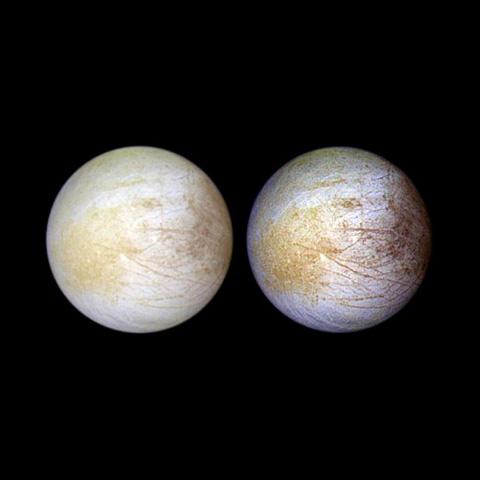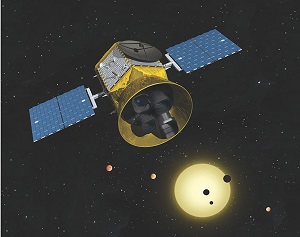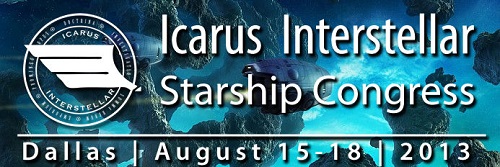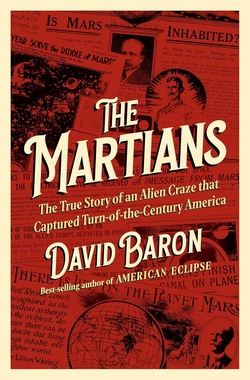Centauri Dreams
Imagining and Planning Interstellar Exploration
Europa: Sulfates and Landing Sites
Last week’s post about the chemistry of Europa’s ocean is nicely complemented by new work on the moon’s interior by Brad Dalton (JPL) and colleagues. Like JPL’s Kevin Hand, who has been looking at the role of hydrogen peroxide in possible subsurface life there, Dalton is in the hunt for ways to learn more about the composition of Europa’s ocean. Both scientists have been using data from the Galileo mission, refining its results to produce new insights.
Usefully, the surface chemistry on Europa is affected by the charged particles continually striking the tiny world. That allows us to get a read on which parts of Europa would be the best targets for future spacecraft missions, for Dalton’s work helps us find the places where charged particles have had the smallest impact. It’s there — on parts of the leading hemisphere in Europa’s orbit — that material from within the ocean is most likely to be found in pristine condition, with the least chemical processing by incoming charged electrons and ions.
Here’s the mechanism: Europa keeps the same side toward Jupiter as it moves around the planet in its orbit. At the same time, Jupiter’s magnetic field is tugging ions of sulfur and oxygen from Io along the same path, as well as charged energetic particles that move much faster than Europa’s 3.6-day orbit. What happens is that the trailing hemisphere of Europa winds up with more sulfuric acid, apparently the result of sulfur ions bombarding the surface. Dalton’s team takes those earlier Galileo observations further by looking at five different parts of the surface.
Image: This graphic of Jupiter’s moon Europa maps a relationship between the amount of energy deposited onto the moon from charged-particle bombardment and the chemical contents of ice deposits on the surface in five areas of the moon (labeled A through E). Energetic ions and electrons tied to Jupiter’s powerful magnetic field smack into Europa as the field sweeps around Jupiter. The magnetic field travels around Jupiter even faster than Europa orbits the planet. Most of the energetic particles hitting Europa strike the moon’s “trailing hemisphere,” the half facing away from the direction Europa travels in its orbit. The “leading hemisphere,” facing in the direction of travel, receives fewer of the charged particles. Credit: NASA/JPL-Caltech/Univ. of Ariz./JHUAPL/Univ. of Colo.
Hydrated sulfuric acid and hydrated sulfate salts can be distinguished from water ice by the spectra gathered by Galileo’s Near-Infrared Mapping Spectrometer. Dalton and team are looking at the reflected light from frozen material on the surface, and comparing what they see with their models of what the particle bombardment from Jupiter and Io should produce. It turns out that sulfuric acid varies from undetectable levels near the center of the leading hemisphere to more than half of the surface materials near the center of the trailing hemisphere. The amount of electrons and sulfur ions hitting the surface shows a close correlation with this result.
So whatever chemical compounds may originally have erupted from the interior onto the surface, they’re most likely to be found unchanged on the leading edge. Says Dalton:
“The darkest material, on the trailing hemisphere, is probably the result of externally-driven chemical processing, with little of the original oceanic material intact. While investigating the products of surface chemistry driven by charged particles is still interesting from a scientific standpoint, there is a strong push within the community to characterize the contents of the ocean and determine whether it could support life. These kinds of places just might be the windows that allow us to do that.”
Europa is going to be a tough environment to work in given its high radiation environment. But work in it we must, because although oceans are also possible on Ganymede and Callisto, it’s Europa that seems to have thinnest crust, making it more likely that oceanic materials are preserved in frozen form on the surface there. To continue the investigation of Europan landing sites for future probes, another recent paper by Edward Sittler (University of Maryland) and team on plasma ion measurements near Europa makes that case that we need a 3-D model of the interactions between moon and magnetosphere to develop a global view of the electric and magnetic fields and the associated plasma environment our probes will have to work in.
The paper is Dalton et al., “Exogenic controls on sulfuric acid hydrate production at the surface of Europa,” Planetary and Space Science, Volume 77 (March 2013), pp. 45-63 (abstract). The Sittler paper is “Plasma Ion Composition Measurements for Europa,” available online at Planetary and Space Science 13 March 2013 (abstract).

Starship Congress
No stranger to these pages, Richard Obousy is president and senior scientist for Icarus Interstellar, which among other things is engaged in the ambitious redesign of Project Daedalus. But the organization has more on its plate than a fusion-powered starship. From worldships to lightsails, Icarus Interstellar is probing the possibilities both near-term and far, all of which will be discussed at an upcoming gathering of the interstellar community that Richard now describes.
by Richard Obousy

Starship Congress is the interstellar summit that Icarus Interstellar is hosting this summer in Dallas, August 15-18. As an event, Starship Congress will play host and give voice to a wide variety of interstellar organizations and distinguished proponents from the interstellar community. Registration for Starship Congress is now open on Icarus Interstellar’s website. A call-for-papers has been made with selected presenter’s papers to be published in a special Starship Congress-dedicated issue of the Journal of the British Interplanetary Society.
The event is split into three days, with each day advancing progressively in terms of its focus on the future of science and technology.
Day 1—Interstellar Now
Day 1 will examine what we can do today and for the next twenty years. The aim is getting the interstellar community to think about critical building blocks needing to be addressed in the near term in order to establish the correct social, economic and technological conditions leading to the building and launch of a starship before the end of the century.
Day 2—Interstellar This Lifetime
DAY 2 will be focused on semi-realistic targets for what we may see accomplished from 20-to-50 years from now. Likely areas of discussion will be technologies that are presently considered to be at low-technology readiness level (TRL). On the propulsion side of things this will include fusion and antimatter rockets. There will also be discussions on the human exploration and colonization of our own solar system as a plausible next-step on way to becoming an interstellar civilization.
Day 3—Interstellar Future
DAY 3 will be focused on topics that are deemed speculative by today’s standards. Warp drives, wormholes, the extraction of energy from the quantum vacuum, are examples of the kinds of talks and discussions that are planned. In addition, papers and presentations are anticipated on ‘mega-engineering’ projects such as space elevators and terraforming. The consideration of social aspects of long distance space exploration will be talked about. (For example, how do closed communities evolve in space, and how do we ensure the protection of minorities on such a mission while limiting religious extremism?) Similarly, another interesting topic can be the degree of autonomy an interstellar crew have from the population that funded their mission.
Speaking for myself, as president of Icarus Interstellar I’m deeply cognizant of the relatively low interest there is globally in putting money into space exploration, and therefore the questionable assertion that we’ll be ‘going interstellar’ anytime soon. As an example, the annual budget of the US Department of Defense is about equal to the sum total of money NASA has ever spent since its inception in 1958. However, I’m also mindful of the unpredictable effects of disruptive technologies and the profound social and technological advancements humanity has seen in the last century. So Icarus will stick to its ambition of launching an expansive campaign of interstellar exploration and colonization to commence by the end of the century.
Idealistic? Undoubtedly. Possible? Yes.
The Era of Planet Gathering
We’ve looked at a couple of exoplanet issues this week that bear further comment. The first is that different detection methods can be usefully combined to cover different scenarios. If radial velocity works best with larger planets closer to their star, direct imaging takes us deep into the outer planetary system. We saw yesterday how both imaging and radial velocity could be used to probe subgiant stars. We routinely use RV as a check on transiting planet candidates. And gravitational microlensing can find planets at a wide range of separation from their primary.
I think microlensing has plenty to teach us, though I’m sensitive to the criticism voiced in comments here that we’re dealing with non-repeating events when we have a microlensing detection. Centauri Dreams reader coolstar has also noted that distance may be a factor, questioning whether some of the resources by way of telescope hardware that we’re putting into microlensing studies wouldn’t be better employed looking at nearby worlds. After all, a new paper by Timothy Morton and Jonathan Swift makes the case that small planets around M-dwarfs are even more plentiful than recent studies reported here have shown. Maybe we should be putting more of an effort into finding these through transit studies?
If different detection methods each have their uses, radically different classes of telescope can likewise probe for planets. John Johnson (Caltech) heads up Project Minerva, a telescope array dedicated to Earth-like planets around nearby stars. The plan is to use small-aperture robotic telescopes atop Palomar Mountain to perform photometry and high-resolution spectroscopy, making it, according to Caltech’s site on the project, “the first U.S. observatory dedicated to exoplanetary science capable of both precise radial velocimetry and transit studies.” Following an initial design review, the project has now seen delivery of the enclosure for its telescopes.

Image: Minerva’s hardware. Minerva will be an array of small-aperture robotic telescopes to be built atop Palomar Mountain outfitted for both photometry and high-resolution spectroscopy. It will be the first U.S. observatory dedicated to exoplanetary science capable of both precise radial velocimetry and transit studies. The multi-telescope concept will be implemented to either observe separate targets or a single target with a larger effective aperture. The flexibility of the observatory will maximize scientific potential and also provide ample opportunities for education and public outreach. The design and implementation of MINERVA will be carried out by postdoctoral and student researchers at Caltech. Credit: Caltech/John Johnson.
TESS, the Transiting Exoplanet Survey Satellite, stands as a logical follow-on to the Kepler mission because it takes the hunt to nearby stars even as Kepler’s candidate totals push on toward 3000. But as we wait for new instruments to come online, including the upcoming James Webb Space Telescope and ground-based systems like the European Extremely Large Telescope, it’s great to see grad students like Johnson’s Exolab crew coming up with solutions like Minerva. It’s an inexpensive effort that could gain real traction, and as Johnson told one reporter, “If we lived in an ideal world, we wouldn’t do Minerva because we’d have money from our funding agencies.” But then, who ever said it was an ideal world?
Minerva had a poster devoted to it at the most recent meeting of the American Astronomical Society. The plan is to use an array of four instruments, each with a 0.7-meter mirror, that will over a period of three years scan stars within about 75 light years of the Earth. To get a look at it, see Unblinking Baby Telescopes Will Hunt Exoplanets for Cheap, a recent piece that explains the project this way:
The Minerva telescopes will look for a slight wobble that indicates a planet is tugging gravitationally on those stars. Using this data, [graduate student Kristina] Hogstrom said that her team expects to find around a dozen new local planets, most of them two to three times the size of Earth and a few of them orbiting in the habitable zone where liquid water could exist. The project will also find Earth-sized planets and perhaps smaller, but these will likely orbit too close to their parent star to host life.
What I like about this, and I can see why Centauri Dreams readers find it interesting, is that it’s a dedicated exoplanet project that, Kepler-like, stares at a designated number of stars. The article quotes Johnson as saying that astronomers aren’t really in planet ‘hunting’ mode these days so much as engaged in routine planet ‘gathering,’ which tells you how far we’ve come in this remarkable enterprise in the few short years since 1995, when the announcement of the first planet discovered orbiting a main sequence star was made by Michel Mayor and Didier Queloz, to be quickly confirmed by Geoff Marcy and Paul Butler.
So here we are with off-the-shelf hardware and a custom-built spectrometer, running up a tab of about $3.5 million as compared to the $600 million that the relatively cheap space-based Kepler cost. We’re probably less than a year away from the datastream beginning to flow at the Minerva site. Modest funding and limited resources used imaginatively in arrays of small dedicated telescopes may be forced upon us by circumstance, but we’re learning that good science can flow from such projects and private institutions can find ways to fund them.

Planetary Systems Around Subgiant Stars
Our exoplanet detection methods have their limits. Radial velocity studies work great in the inner regions of planetary systems, but become more challenging as we move away from the star. Direct imaging is the reverse — we’re most likely to see a distant planet if it’s both large and well separated from the primary. Clearly we need to take the best data from each available method to characterize a planetary system. But direct images are rare and some stars — A-class in particular — are tricky for RV studies because of jitter and other problems. If you want to get in close to an intermediate mass star to look for planets or a debris disk, the way to do it seems to be to study ‘retired’ stars sitting on the subgiant branch of the Hertzsprung-Russell diagram.
These are stars that have slowed or stopped fusing hydrogen in their cores. Core contraction raises the star’s temperature enough to fuse hydrogen in a shell surrounding the core and the star begins to swell up toward giant status. A team led by Amy Bonsor (Institute de Planétologie et d’Astrophysique de Grenoble) has been looking at ? Coronae Borealis (? CrB), also known as HD 142091, using data from the Herschel space telescope in the far infrared. ? CrB turns out to be unique, offering an example of a debris disc around a subgiant and “…a rare example of an intermediate mass star, where both planets and planetesimal belts have been detected.”
That brief quote from the paper on this work goes on to note that the planets and debris disk here can tell us something about planet formation around such stars. There is much we need to learn — some studies have found that more giant planets tend to form around higher mass stars than lower ones, and we’d like to tune up planet formation models in this area. ? Coronae Borealis is a star of about 1.8 solar masses at a distance of 100 light years, some 2.5 billion years old. Previous radial velocity work has revealed one giant planet of about two Jupiter masses orbiting at a distance similar to the asteroid belt in our Solar System. The paper presents Keck measurements offering evidence for a second companion whose mass is unclear.

Image: Kappa Coronae Borealis, based on Herschel PACS observations at 100 ?m. North is up and east is left. The star is in the centre of the frame (not visible in this graphic) with an excess of infrared emission detected around it, interpreted as a dusty debris disc containing asteroids and/or comets. The inclination of the planetary system is constrained at an angle of 60º from face-on. Credit: ESA/Bonsor et al (2013).
These observations yield several possible configurations for the debris disk and planets, with the interesting possibility that the disk may be divided into two narrow belts (centered at 40 AU and 165 AU respectively) with the outermost planet being in actuality a brown dwarf. Another model has a single continuous dust belt extending from 20 to 220 AU, with a planet sculpting the inner edge of the disk. A third possibility: The disk is being stirred by two planets so that the rate of dust production in the disk peaks at roughly 80 AU from the star. Says Bonsor: “It is a mysterious and intriguing system: is there a planet or even two planets sculpting one wide disc, or does the star have a brown dwarf companion that has split the disc in two?”
From the paper:
As the ?rst example of a planetary system orbiting a subgiant, a more detailed population study is required to determine whether or not ? CrB is unusual, nonetheless, this work suggests that ? CrB did not su?er any dynamical instability that cleared out its planetary system, similar to the Late Heavy Bombardment. As the ?rst example of a > 1.4M? star, with a giant planet interior to 8AU, where there is also resolved imaging of a debris disc, ? CrB provides a good example system from which to further our understanding of planetary systems around intermediate mass stars.
The paper is Bonsor et al., “Spatially Resolved Images of Dust Belt(s) Around the Planet-hosting Subgiant ? CrB,” accepted for publication in Monthly Notices of the Royal Astronomical Society (preprint). More in this ESA news release.

The Chemistry of Europa’s Ocean
The news that hydrogen peroxide is found across much of the surface of Europa is intriguing. The global ocean beneath the moon’s icy crust would turn hydrogen peroxide into oxygen, assuming there is some mixing between the surface and the ocean. We don’t know if that mixing occurs, but if it does, then we may be looking at a useful chemical energy source for life. Given that I spent much of last week writing about Arthur C. Clarke, this thought invariably brings up a recent viewing of 2010: Odyssey II and the injunction beamed to Earth: “All these worlds are yours except Europa. Attempt no landing there.”
Europa is increasingly irresistible the more we learn about it. Here’s Kevin Hand (Jet Propulsion Laboratory) on the question of hydrogen peroxide’s possible role:
“Life as we know it needs liquid water, elements like carbon, nitrogen, phosphorus and sulfur, and it needs some form of chemical or light energy to get the business of life done. Europa has the liquid water and elements, and we think that compounds like peroxide might be an important part of the energy requirement. The availability of oxidants like peroxide on Earth was a critical part of the rise of complex, multicellular life.”

Image: This color composite view combines violet, green, and infrared images of Jupiter’s intriguing moon, Europa, for a view of the moon in natural color (left) and in enhanced color designed to bring out subtle color differences in the surface (right). The bright white and bluish part of Europa’s surface is composed mostly of water ice, with very few non-ice materials. In contrast, the brownish mottled regions on the right side of the image may be covered by hydrated salts and an unknown red component. The yellowish mottled terrain on the left side of the image is caused by some other unknown component. Long, dark lines are fractures in the crust, some of which are more than 3,000 kilometers (1,850 miles) long. Credit: JPL.
Hand and Caltech’s Mike Brown went to work on Europa using near-infrared data from the Keck II instrument on Mauna Kea. The hydrogen peroxide they found is some 20 times more diluted than what you might buy at the local drugstore, and it’s unevenly distributed on the surface. Here it’s important to remember that Europa is locked to Jupiter — it rotates on its axis once for every 86 hour orbit around the planet — so its hemispheres keep the same orientation toward Jupiter and, importantly, the radiation environment in the magnetosphere. In terms of hydrogen peroxide, the highest concentration (0.12 percent relative to water) is to be found on the leading side; i.e., the side that leads in Europa’s orbit around Jupiter. The side that faces backward in the moon’s orbit shows a concentration of peroxide that drops off to close to zero.
The work also shows that peroxide is at its highest concentration in areas where the ice is nearly pure water, a fact discussed in the paper, which ran in Astrophysical Journal Letters. It was the Galileo mission that first detected hydrogen peroxide on Europa, and the new work adjusts our view of its distribution. In the passage below, NIMS refers to the Galileo spacecraft’s Near-Infrared Spectrometer, which made the hydrogen peroxide detection:
…we note that the radiolytic production of surface oxidants has long been of interest in the context of Europa’s subsurface ocean chemistry (Gaidos et al. 1999; Chyba 2000; Chyba & Hand 2001). If Europa’s oxidant laden surface ice mixes with the ocean water then radiolysis could be a key mechanism for maintaining a chemically-rich and potentially habitable ocean (Chyba 2000; Hand et al. 2009). Previous estimates all assumed a globally uniform layer of peroxide within the ice layer and calculated delivery rates based the NIMS concentration of 0.13% relative to water.
But now we learn that the distribution is not globally uniform:
Our new results indicate that only the most ice-rich regions of Europa reach the concentrations measured by NIMS. The trailing hemisphere concentration is nearly an order of magnitude lower than the leading hemisphere and the sub- and anti-Jovian hemispheres are down by a factor of ?3 relative to the leading hemisphere. As a result, the average global surface abundance of peroxide in the surface ice of Europa may be better represented by the sub- and anti-Jovian hemisphere concentrations of ?0.044%. This reduces the low-end estimate of Chyba & Hand (2001) from ? 109 moles per year peroxide delivered to the ocean to ? 108 moles per year delivered.
Given its importance for the habitability of the global ocean, the more we learn about hydrogen peroxide and its distribution, the better. We’re refining the Galileo results, but hampered by the lack of resources in the Jovian system — the paper goes on to point out that the cold water ice regions of the poles are not readily observable from Earth. But the work lowers our estimates of the total oxidants delivered to the ocean, assuming that there is indeed exchange of material between the surface ice and the water below. The case for a habitable ocean is still there to be made, but until we know more about delivery mechanisms, we’re left with huge imponderables.
The paper is Hand and Brown, “Keck II Observations of Hemispherical Differences in H2O2 on Europa,” Astrophysical Journal Letters 766 (2013), L21 (preprint). More in this JPL news release.

TESS: A Full-Sky Exoplanet Survey
The news that NASA has approved the TESS mission kept my mood elevated all weekend. TESS (Transiting Exoplanet Survey Satellite) has been the logical NASA follow-up to Kepler ever since the Space Interferometry Mission was canceled in 2010. The point is that Kepler looks at a field of stars with the goal of developing a statistical analysis, helping us (ultimately) to home in on the value for ?Earth (Eta_Earth), the fraction of stars orbited by planets like the Earth.
To do this, Kepler is looking out along the Orion Arm of the galaxy, with almost all the stars in its field of view between 600 and 3000 light years away. In fact, fewer than one percent of Kepler’s 156,000 stars are closer than 600 light years. There are plenty of stars beyond 3000 light years, but as we push beyond this distance, the stars become too faint for Kepler’s transit methods to be effective. The carefully chosen field in Cygnus and Lyra is ideal for Kepler’s statistical data but the next question to ask is how many Earth-like planets are to be found around relatively nearby stars.

TESS is led by principal investigator George Ricker (MIT Kavli Institute for Astrophysics and Space Research), whose team will be working with an array of wide-field cameras to perform an all-sky survey, as opposed to the intense ‘stare’ Kepler makes at a particular starfield. Ricker says the mission should be able to identify thousands of new planets in the solar neighborhood in a survey that will cover 400 times as much sky as any previous exoplanet mission.
We all have ideal missions we’d like to see fly, from the Space Interferometry Mission to some sort of grandly designed Terrestrial Planet Finder, but among the realistic options in front of us, TESS makes abundant sense. It will home in on small rocky planets and help us measure their mass, density, size and orbit, along with offering up data on their atmospheres. And you can also think of TESS as something of a pointer scope for the James Webb Space Telescope and other future instruments that will begin the hunt for astrobiological signatures on other worlds.
Image: TESS’s primary goal would be to identify terrestrial planets orbiting nearby stars. Credit: MIT Kavli Institute for Astrophysics & Space Research.
“The TESS legacy,” says Ricker, “will be a catalog of the nearest and brightest main-sequence stars hosting transiting exoplanets, which will forever be the most favorable targets for detailed investigations.” That makes the $200 million funding for this bird money well spent. In an interview on the Kavli Foundation site, Ricker adds that the interactions of multiple planets as they orbit their host star, spotted through transit timing variations, can aid the search:
Measuring transit time variations is particularly important because if you find a large Neptune- or Saturn-sized planet that appears to be tugged a little bit, you can make an estimate of how massive the planet is that is actually doing the tugging. Measuring transit time variations, which is a technique enabled by Kepler data, is a bit like successively unnesting a Russian matryoshka doll – you go a few layers down and you can find smaller and smaller planets in the system. That’s one of the things that doing transit time variations, during the TESS mission, will enable us to do.
In other words, we’ll have TESS spotting planets around stars bright enough for ground-based telescopes to home in on these transit time variations (TTV), something we can’t readily do with most of the Kepler planets because their stars are too faint. The system is designed to detect changes in the intensity of a star’s light down to 40 parts per million. By comparison, Earth viewed from outside the Solar System would cause a transit drop of about 85 parts per million. Ricker estimates that TESS will be able to detect as many as 2700 planets, including several hundred Earth-size worlds. The TESS mission is now scheduled for launch in 2017.




